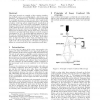Free Online Productivity Tools
i2Speak
i2Symbol
i2OCR
iTex2Img
iWeb2Print
iWeb2Shot
i2Type
iPdf2Split
iPdf2Merge
i2Bopomofo
i2Arabic
i2Style
i2Image
i2PDF
iLatex2Rtf
Sci2ools
VISUALIZATION
1996
IEEE
1996
IEEE
Visualization of Laser Confocal Microscopy Datasets
This paper presents an example of how existing visualization methods can be successfully applied { after minor modi cations { for allowing new, sometimes unexpected insight in scienti c questions, in this case for better understanding unknown, microscopic biological structures. We present a volume rendering system supporting the visualization of LCM datasets, a new microscopic tomographic method allowing for the rst time accurate and fast in-vivo inspection of the spatial structure of microscopic structures, especially important in (but not restricted to) biology. The speed, exibility and versatility of the system allows fast, convenient, interactive operation with large datasets on small computers (workstation or PC). By testing di erent datasets we have been able to signi cantly improve the performance of understanding the internal structure of LCM data. Most important, we have been able to show static and dynamic structures of cells never seen before and allowing signi cant insight...
Fast In-vivo Inspection | Microscopic Biological Structures | Microscopic Tomographic Method | Visualization | VISUALIZATION 1996 |
| Added | 07 Aug 2010 |
| Updated | 07 Aug 2010 |
| Type | Conference |
| Year | 1996 |
| Where | VISUALIZATION |
| Authors | Georgios Sakas, Michael G. Vicker, Peter Jörg Plath |
Comments (0)

